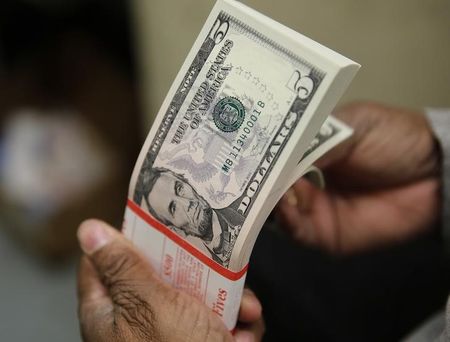 © Reuters.
© Reuters.
By Gina Lee
Investing.com – The dollar was up on Friday morning in Asia, with investors continuing to bet on further declines as optimism that the COVID-19 pandemic is slowly starting to come to an end. The euro, on the other hand, benefitted from the dollar’s weakness and looked set to close its best week in a month.
“The euro is holding above the $1.21 level for the first time since spring 2018, despite the fact that there is only a week to go before the European Central Bank (ECB) is expected to add more policy stimulus,” Rabobank strategist Jane Foley told Reuters.
“There is no doubt that the actions of the U.S. Federal Reserve have been hugely successful at weakening the value of the dollar since the spring this year,” she added.
The U.S. Dollar Index that tracks the greenback against a basket of other currencies inched up 0.03% to 90.688 by 9:38 PM ET (1:38 AM GMT).
The index has slid around 12% from a three-year high of 102.990 in March to a two-and-a-half year low of 90.504 seen on Thursday. Investors have a heavily short dollar stance recently, over bets that rates in the U.S. will stay low for a long time and being forcing yield-seekers to search for better returns elsewhere.
Even the ever-rising number of COVID-19 cases and lockdowns in the U.S. failed to turn investors to the safe-haven asset. Investors continue to place their bets on more government support, either through further monetary easing or fiscal spending.
A $908 billion COVID-19 aid package was gaining traction in Congress on Thursday, and the Fed is widely expected to expand its bond buying program. Both would see the dollar continue its downward trend, with bond buying keeping yields anchored and spending increasing appetite for riskier currencies.
Both the Fed and ECB will convene for their respective policy meetings during the following week.
The USD/JPY pair inched down 0.02% to 103.81. The euro was also headed for its best week in six months against the yen, but the yen rose a little against the weakened dollar during the previous session.
The AUD/USD pair edged down 0.13% to 0.7428 and the NZD/USD pair edged down 0.16% to 0.7062.
“Call it December seasonality come early, call it what you will, but the market’s appetite for the NZD is insatiable at the moment,” ANZ Bank chief economist Sharon Zollner and strategist David Croy said in a note.
“And while the rubber bands of momentum and valuation are starting to get stretched, technically it looks very solid; commodity prices are rising; and nobody wants to own dollars … a break of 0.7160 would be extremely bullish,” the note added.
The USD/CNY pair inched up 0.07% to 6.5467.
The GBP/USD pair inched down 0.01% to 1.3450. Although the pound saw a one-year high, investors continue to await the outcome of Brexit trade deal talks between the U.K. and the European Union (EU).
“Traders need to assess their sterling exposures into the weekend … if I were running long exposures, I wouldn’t be adding … but questioning, if we see a deal, how punchy the gapping risk will be … if we don’t get a deal and the rhetoric from (Chief EU negotiator Michel) Barnier or the British camp shows limited progress then we could see GBP/USD gap lower on Monday,” Pepperstone head of research Chris Weston told Reuters.
Investors now look to U.S. jobs data, including November’s manufacturing payrolls and non-farm payrolls and due later in the day, for further clues to the U.S. economic recovery from COVID-19.
Leave a comment
